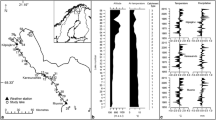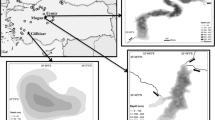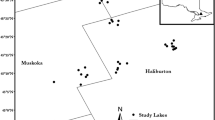Abstract
Zooplankton are potentially powerful proxies for the assessments of biologic integrity. The paleolimnological perspective and use of fossil Cladocera also provide the means to reconstruct reference conditions and natural long-term community dynamics. Unfortunately, the use of zooplankton in lake quality assessments is currently underexploited. We studied a surface sediment dataset of 41 lakes in Finland to examine the relationship between Cladocera remains and environmental variables. Of the examined environmental variables, total phosphorus availability was found to be the most important variable in explaining the Cladocera community composition. Following the tests on species environment relations, we selected a lake trophic typology as the most suitable environmental variable for developing a new tool for limnoecological quality assessments. A test of the model on a modern and historic sample from a eutrophied lake showed that the test lake has proceeded from “mesotrophic/poor” to “eutrophic/bad” limnoecological state in agreement with previous independent evidence. The model developed here showed favorable performance that can be used to provide reliable estimates of ecological and environmental state of lakes.




Similar content being viewed by others
References
Adamczuk, M., 2012. Spatial distribution of juvenile and adult stages of limnetic Cladocera in relation to selected environmental factors. Journal of Limnology 71: 112–118.
Amsinck, S. L., E. Jeppesen & F. Landkildehus, 2005. Relationships between environmental variables and zooplankton subfossils in the surface sediments of 36 shallow coastal brackish lakes with special emphasis on the role of fish. Journal of Paleolimnology 33: 39–51.
Bennion, H. & R. Battarbee, 2007. The European Union Water Framework Directive: opportunities for palaeolimnology. Journal of Paleolimnology 38: 285–295.
Bjerring, R., E. Becares, S. Declerck, E. M. Gross, L.-A. Hansson, T. Kairesalo, M. Nykänen, A. Halkiewicz, R. Kornijów, J. M. Conde-Porcuna, M. Seferlis, T. Nõges, B. Moss, S. L. Amsinck, B. V. Odgaard & E. Jeppesen, 2009. Subfossil Cladocera in relation to contemporary environmental variables in 54 Pan-European lakes. Freshwater Biology 54: 2401–2417.
Borcard, D. & P. Legendre, 2012. Is the Mantel correlogram powerful enough to be used in ecological analysis? A simulation study. Ecology 93: 1473–1481.
Brodersen, K. P., M. C. Whiteside & C. Lindegaard, 1998. Reconstruction of trophic state in Danish lakes using subfossil chydorid (Cladocera) assemblages. Canadian Journal of Fisheries and Aquatic Sciences 55: 1093–1103.
Catalan, J., M. G. Barbieri, F. Bartumeus, P. Bitušik, I. Botev, A. Brancelj, D. Cogălniceanu, M. Manca, A. Marchetto, N. Ognjanova-Rumenova, S. Pla, M. Rieradevall, S. Sorvari, E. Štefková, E. Stuchlík & M. Ventura, 2009. Ecological thresholds in European Alpine lakes. Freshwater Biology 54: 2494–2517.
Chen, G., C. Dalton & D. Taylor, 2010. Cladocera as indicators of trophic state in Irish lakes. Journal of Paleolimnology 44: 465–481.
Davidson, T. A., C. D. Sayer, M. Perrow, M. Bramm & E. Jeppesen, 2010a. The simultaneous inference of zooplanktivorous fish and macrophyte density from sub-fossil cladoceran assemblages: a multivariate regression tree approach. Freshwater Biology 55: 546–564.
Davidson, T. A., C. D. Sayer, P. G. Langdon, A. Burgess & M. Jackson, 2010b. Inferring past zooplanktivorous fish and macrophyte density in a shallow lake: application of a new regression tree model. Freshwater Biology 55: 584–599.
Davidson, T. A., H. Bennion, E. Jeppesen, G. H. Clarke, C. D. Sayer, M. Morley, B. V. Odgaard, P. Rasmussen, R. Rawcliffe, J. Salgado, G. L. Simpson & S. L. Amsinck, 2011. The role of cladocerans in tracking long-term change in shallow lake trophic status. Hydrobiologia 676: 299–315.
de Eyto, E., K. Irvine & G. Free, 2002. The use of members of the family Chydoridae (Anomopoda, Branchiopoda) as an indicator of lake ecological quality in Ireland. Biology and Environment: Proceedings of the Royal Irish Academy 2: 81–91.
de Eyto, E., K. Irvine, F. Garcia-Críado, M. Gyllström, E. Jeppesen, R. Kornijow, M. R. Miracle, M. Nykänen, C. Bareiss, S. Cerbin, J. Salujõe, R. Franken, D. Stephens & B. Moss, 2003. The distribution of chydorids (Branchiopoda, Anomopoda) in European shallow lakes and its application to ecological quality monitoring. Archiv für Hydrobiologie 156: 181–202.
DeSellas, A. M., A. M. Paterson, J. N. Sweetman & J. P. Smol, 2011. Assessing the effects of multiple environmental stressors on zooplankton assemblages in Boreal Shield lakes since pre-industrial times. Journal of Limnology 70: 41–56.
Eggermont, H. & K. Martens, 2011. Preface: cladocera crustaceans: sentinels of environmental change. Hydrobiologia 676: 1–7.
European Commission, 2000. Directive 2000/60/EC of the European Parliament and of the Council of 23 October 2000 on establishing a framework for community action in the field of water policy. Journal of the European Communities L327: 1–72.
European Commission, 2003. Common Implementation Strategy for the Water Framework Directive (2000/60/EC), Guidance Document No. 10, Rivers and Lakes – Typology, Reference Conditions and Classification Systems. Produced by Working Group 2.3 – REFCOND. Luxembourg: Office for Official Publications of the European Communities.
Forsberg, C. & S.-O. Ryding, 1980. Eutrophication parameters and trophic state indices in 30 Swedish waste-receiving lakes. Archiv für Hydrobiologie 89: 189–207.
Frey, D. G., 1960. The ecological significance of cladoceran remains in lake sediments. Ecology 41: 684–699.
Gannon, J. E. & R. S. Stemberger, 1978. Zooplankton (especially crustaceans and rotifers) as indicators of water quality. Transactions of the American Microscopical Society 97: 16–35.
Hammer, Ø., Da. T. Harper & P. D. Ryan, 2001. PAST: Paleontological statistics software package for education and data analysis. Palaeontologia Electronica 4: 9 pp.
Hessen, D. O., B. A. Faafeng, V. H. Smith, V. Bakkestuen & B. Walseng, 2006. Extrinsic and intrinsic controls of zooplankton diversity in lakes. Ecology 87: 433–443.
Hill, M. O. & P. Šmilauer, 2005. TWINSPAN for Windows, Version 2.3. Centre for Ecology and Hydrology, University of South Bohemia, Huntington & České Budejovicě.
Huttunen, P., J. Meriläinen, C. Cotton & J. Rönkkö, 1988. Attempts to reconstruct lake water pH and colour from sedimentary diatoms and Cladocera. Verhandlungen des Internationalen Verein Limnologie 23: 870–873.
Jeppesen, E., E. A. Madsen, J. P. Jensen & N. J. Anderson, 1996. Reconstructing the past density of planktivorous fish and trophic structure from sedimentary zooplankton fossils: a surface sediment calibration set from shallow lakes. Freshwater Biology 36: 115–127.
Jeppesen, E., P. Leavitt, L. De Meester & J. P. Jensen, 2001a. Functional ecology and palaeolimnology: using cladoceran remains to reconstruct anthropogenic impact. Trends in Ecology and Evolution 16: 191–198.
Jeppesen, E., K. Christoffersen, F. Landkildehus, T. Lauridsen, S. L. Amsinck, F. Riget & M. Søndergaard, 2001b. Fish and crustaceans in northeast Greenland lakes with special emphasis on interactions between Arctic charr (Salvelinus alpinus), Lepidurus arcticus and benthic chydorids. Hydrobiologia 442: 329–337.
Jeppesen, E., P. Nõges, T. Davidson, J. Haberman, T. Nõges, K. Blank, T. Lauridsen, M. Søndergaard, C. Sayer, R. Laugaste, L. Johansson, R. Bjerring & S. Amsinck, 2011. Zooplankton as indicators in lakes: a scientific-based plea for including zooplankton in the ecological quality assessment of lakes according to the European Water Framework Directive (WFD). Hydrobiologia 676: 279–297.
Juggins, S., 2007. Program C2 data analysis. Version 1.5.0. University of Newcastle, UK.
Kamenik, C., K. Szeroczyńska & R. Schmidt, 2007. Relationships among recent Alpine Cladocera remains and their environment: implications for climate-change studies. Hydrobiologia 594: 33–46.
Kane, D. D., S. I. Gordon, M. Munawar, M. N. Charlton & D. A. Culver, 2009. The Planktonic Index of Biotic Integrity (P-IBI): an approach for assessing lake ecosystem health. Ecological Indicators 9: 1234–1247.
Kansanen, P., T. Jaakkola, S. Kulmala & R. Suutarinen, 1991. Sedimentation and distribution of gamma-emitting radionuclides in bottom sediments of southern Lake Päijänne, Finland, after the Chernobyl accident. Hydrobiologia 222: 121–140.
Korhola, A., 1999. Distribution patterns of Cladocera in subarctic Fennoscandian lakes and their potential in environmental reconstruction. Ecography 22: 357–373.
Korhola, A. & M. Rautio, 2001. Cladocera and other branchiopod crustaceans. In Smol, J. P., H. J. B. Birks & W. M. Last (eds), Tracking Environmental Change Using Lake Sediments, Vol 4: Zoological Indicators. Kluwer, Dordrecht: 5–41.
Korosi, J. & J. P. Smol, 2011. Distribution of cladoceran assemblages across environmental gradients in Nova Scotia (Canada) lakes. Hydrobiologia 663: 83–99.
Krause-Dellin, D. & C. Steinberg, 1986. Cladoceran remains as indicators of lake acidification. Hydrobiologia 143: 129–134.
Kultti, S., L. Nevalainen, T. P. Luoto & K. Sarmaja-Korjonen, 2011. Subfossil chydorid (Cladocera, Chydoridae) ephippia as paleoenvironmental proxies: evidence from boreal and subarctic lakes in Finland. Hydrobiologia 676: 23–37.
Legendre, P. & L. Legendre, 1998. Numerical ecology. Elsevier, Amsterdam.
Lotter, A. F., H. J. B. Birks, W. Hofmann & A. Marchetto, 1998. Modern diatom, cladocera, chironomid, and chrysophyte cyst assemblages as quantitative indicators for the reconstruction of past environmental conditions in the Alps II. Nutrients. Journal of Paleolimnology 19: 43–463.
Louette, G., S. Declerck, J. Vandekerkhove & L. De Meester, 2009. Evaluation of restoration measures in a shallow lake through a comparison of present day zooplankton communities with historical samples. Restoration Ecology 17: 629–640.
Luoto, T. P., 2010. Hydrological change in lakes inferred from midge assemblages through use of an intralake calibration set. Ecological Monographs 80: 303–329.
Luoto, T. P., 2011. The relationship between water quality and chironomid distribution in Finland – a new assemblage-based tool for assessments of long-term nutrient dynamics. Ecological Indicators 11: 255–262.
Luoto, T. P., 2012. Intra-lake patterns of aquatic insect and mite remains. Journal of Paleolimnology 47: 141–157.
Luoto, T. P. & L. Nevalainen, 2011. Inferring reference conditions of hypolimnetic oxygen for deteriorated Lake Mallusjärvi in the cultural landscape of Mallusjoki, southern Finland using fossil midge assemblages. Water, Air, and Soil Pollution 217: 663–675.
Luoto, T. P. & L. Nevalainen, 2012. Ecological responses of aquatic invertebrates to climate change over the past ~400 years in a climatically ultra-sensitive lake in the Niedere Tauern Alps (Austria). Fundamental and Applied Limnology. doi:10.1127/1863-9135/2012/0341.
Luoto, T. P. & J. Raunio, 2011. A comparison of chironomid-based total phosphorus training sets developed from contemporary pupal exuviae and sedimentary larval head capsules to infer lake trophic history. Fundamental and Applied Limnology 179: 93–102.
Luoto, T. P. & V.-P. Salonen, 2010. Fossil midge larvae (Diptera: Chironomidae) as quantitative indicators of late-winter hypolimnetic oxygen in southern Finland: a calibration model, case studies and potentialities. Boreal Environment Research 15: 1–18.
Luoto, T. P., K. Sarmaja-Korjonen, L. Nevalainen & T. Kauppila, 2009. A 700 year record of temperature and nutrient changes in a small eutrophied lake in southern Finland. The Holocene 19: 1063–1072.
Luoto, T. P., L. Nevalainen, S. Kultti & K. Sarmaja-Korjonen, 2011. An evaluation of the influence of water depth and river inflow on quantitative Cladocera-based temperature and lake level inferences in a shallow boreal lake. Hydrobiologia 676: 143–154.
Makarewicz, J. C. & G. E. Likens, 1979. Structure and function of the zooplankton community of Mirrow Lake, New Hampshire. Ecological Monographs 49: 109–127.
Manca, M. & M. Armiaglio, 2002. Zooplankton of 15 lakes in the Southern Central Alps: comparison of recent and past (pre-ca 1850 AD) communities. Journal of Limnology 14: 113–122.
Mantel, N., 1967. The detection of disease clustering and a generalized regression approach. Cancer Research 27: 209–220.
Mantel, N. & R. S. Valand, 1970. A technique of nonparametric multivariate analysis. Biometrics 26: 547–558.
Moss, B., et al., 2003. The determination of ecological status in shallow lakes – a tested system (ECOFRAME) for implementation of the European Water Framework Directive. Aquatic Conservation 13: 507–549.
Nevalainen, L., 2010. Evaluation of microcrustacean (Cladocera, Chydoridae) biodiversity based on sweep net and surface sediment samples. Écoscience 17: 356–364.
Nevalainen, L., 2011. Intra-lake heterogeneity of sedimentary cladoceran (Crustacea) assemblages forced by local hydrology. Hydrobiologia 676: 9–22.
Nevalainen, L., 2012. Distribution of benthic microcrustaceans along a water depth gradient in an Austrian Alpine lake – sedimentary evidence for niche separation. Limnologica 42: 65–71.
Nevalainen, L. & T. P. Luoto, 2010. Implications for the use of sedimentary invertebrate communities to infer past presence of fish. Knowledge and Management of Aquatic Ecosystems 396(5): 1–13.
Nevalainen, L. & T. P. Luoto, 2012. Faunal (Chironomidae, Cladocera) responses to post-Little Ice Age climate warming in the high Austrian Alps. Journal of Paleolimnology. doi:10.1007/s10933-012-9640-3.
Nevalainen, L., T. P. Luoto, S. Levine & M. Manca, 2011a. Modern and pre-industrial age distributions of Cladocera in Italian and Swiss Alpine lakes. Hydrobiologia 676: 173–185.
Nevalainen, L., K. Sarmaja-Korjonen & T. P. Luoto, 2011b. Sedimentary Cladocera as indicators of past water-level changes in shallow northern lakes. Quaternary Research 75: 430–437.
Nevalainen, L., T. P. Luoto, S. Kultti & K. Sarmaja-Korjonen, 2012. Do subfossil Cladocera and chydorid ephippia disentangle Holocene climate trends? The Holocene 22: 291–299.
Nõges, P., W. van de Bund, A. C. Cardoso, A. G. Solimini & A.-S. Heiskanen, 2009. Assessment of the ecological status of European surface waters: a work in progress. Hydrobiologia 633: 197–211.
Nykänen, M., T. Kairesalo, S. Mäkelä, E. Huitu, P. Ala-Opas & J. Mannio, 2005. A typology and ecological classification system for Finnish lakes: applicability of the ECOFRAME scheme. Boreal Environment Research 10: 159–179.
Nykänen, M., T. Malinen, K. Vakkilainen, M. Liukkonen & T. Kairesalo, 2010. Cladoceran community responses to biomanipulation and re-oligotrphication in Lake Vesijärvi, Finland, as inferred from remains in annually laminated sediments. Freshwater Biology 55: 1164–1181.
Räike, A., O. P. Pietiläinen, S. Rekolainen, P. Kauppila, H. Pitkänen, J. Niemi, A. Raateland & J. Vuorenmaa, 2003. Trends of phosphorus, nitrogen, and chlorophyll a concentrations in Finnish rivers and lakes in 1975–2000. Science of the Total Environment 310: 47–59.
Sæther, O. A., 1979. Chironomid communities as water quality indicators. Holarctic Ecology 2: 65–74.
Saros, J. E., 2009. Integrating neo- and paleolimnological approaches to refine interpretations of environmental change. Journal of Paleolimnology 41: 243–252.
Sayer, C. D., T. A. Davidson, J. I. Jones & P. G. Langdon, 2010. Combining contemporary ecology and paleolimnology to understand shallow lake ecosystem change. Freshwater Biology 55: 487–499.
Schindler, D. W., 2006. Recent advances in the understanding and management of eutrophication. Limnology and Oceanography 51: 356–363.
Siitonen, S., M. Väliranta, J. Weckström, S. Juutinen & A. Korhola, 2011. Comparison of Cladocera-based water-depth reconstruction against other types of proxy data in Finnish Lapland. Hydrobiologia 676: 155–172.
Simpson, G. L., E. M. Shilland, J. M. Winterbottom & J. Keay, 2005. Defining reference conditions for acidified waters using a modern analogue approach. Environmental Pollution 137: 119–133.
Smol, J. P., 2010. The power of the past: using sediments to track the effects of multiple stressors on lake ecosystems. Freshwater Biology 55: 43–59.
Szeroczyńska, K. & K. Sarmaja-Korjonen, 2007. Atlas of subfossil Cladocera from Central and Northern Europe. Friends of the Lower Vistula Society, Swiecie.
Telford, R. & H. J. B. Birks, 2005. The secret assumption of transfer functions: problems with spatial autocorrelation in evaluating model performance. Quaternary Science Reviews 28: 1309–1316.
ter Braak, C. J. F. & P. Šmilauer, 2002. CANOCO Reference Manual and CanoDraw for Windows User’s Guide: Software for Canonical Community Ordination (version 4.5). Microcomputer Power, Ithaca.
UNEP, 1999. Planning and Management of Lakes and Reservoirs: An International Approach to Eutrophication. IETC Technical Publication Series 11.
Walseng, B., G. Halvorsen & S.-E. Sloreid, 2001. Littoral microcrustaceans (Cladocera and Copepoda) as indices of recovery of a limed water systems. Hydrobiologia 450: 159–172.
Willby, N., V. Abernethy & B. Demars, 2000. Attribute-based classification of European hydrophytes and its relationship to habitat utilization. Freshwater Biology 43: 43–74.
Acknowledgments
The material used in this study was collected during the EPHIPPIUM project (Academy of Finland, grant #1107062). Personal grants from the Academy of Finland (ILMAVEIVI-project, grant #250343) for T.P. Luoto and from the Kone Foundation (EGGER-project) for L. Nevalainen are deeply appreciated. We thank the members of the Ephippium project field team, Seija Kultti, Susanna Kihlman, and Anu Hakala, for their help in collecting the material. We are also grateful for the two reviewers for providing constructive comments that significantly improved the value of the paper.
Author information
Authors and Affiliations
Corresponding author
Additional information
Handling editor: Jasmine Saros
Rights and permissions
About this article
Cite this article
Luoto, T.P., Nevalainen, L. & Sarmaja-Korjonen, K. Zooplankton (Cladocera) in assessments of biologic integrity and reference conditions: application of sedimentary assemblages from shallow boreal lakes. Hydrobiologia 707, 173–185 (2013). https://doi.org/10.1007/s10750-012-1422-4
Received:
Revised:
Accepted:
Published:
Issue Date:
DOI: https://doi.org/10.1007/s10750-012-1422-4




